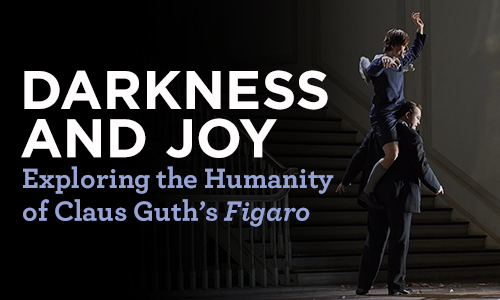-
Darkness and Joy: Exploring the Humanity of Claus Guth's Figaro
By Gianmarco SegatoPosted in Marriage of FigaroBy: Gianmarco Segato

Claus Guth’s production of The Marriage of Figaro has had a lengthier gestation period than most. It premiered at the 2006 Salzburg Festival, was quickly revived there in 2007 and 2009, and culminated in the German director staging all three of Mozart’s collaborations with librettist Lorenzo da Ponte at the 2011 festival (Don Giovanni being added in 2008 and Così fan tutte in 2009). Initially, Guth resisted Mozart’s iconic comedy, questioning whether it was possible for him to confront the dangerous elements in a work whose music he had enjoyed with “uncontrolled excess”* while growing up. It was the Salzburg production’s first conductor, Nikolaus Harnoncourt, who managed to shift Guth’s focus away from Figaro’s distractingly glittery musical delights towards its intelligent, witty exploration of real, human relationships—the very elements that pushed comic opera beyond its more formulaic, slapstick Italian commedia dell’arte roots.
From this emerged an interpretation that relocates the action from 18th-century Andalusia to fin-de-siècle Central Europe by way of the intense, modernist stage dramas of Ibsen and Strindberg, and the films of Ingmar Bergman.
Guth’s concept for his Figaro was by no means static, enmeshed as it became with his simultaneous stagings of Don Giovanni and Così fan tutte. He began to identify fascinating crossovers and linkages between specific character types within the Mozart/da Ponte trilogy. For example, Guth came to view Figaro’s philandering Count Almaviva as a double for the womanizing anti-hero, Don Giovanni. Accordingly, he portrays the Count as a middle-aged, sex-obsessed roué who despite carrying on an affair with his wife’s maid, Susanna, still struggles to maintain a degree of bourgeois domesticity. He constantly mops his sweaty brow with a white handkerchief, panic-stricken he will be caught in the act.
This production’s most striking directorial intervention comes in the form of a non-speaking character, Cherubim, costumed exactly like the page, Cherubino. His silent, trickster-like presence (he has been portrayed by dancer and champion unicyclist Uli Kirsch in all iterations of the production) functions a lot like the personification of Love/Eros in early Baroque opera; he is invisible to the other characters and frequently manipulates them, pushing them together or pulling them apart. Guth’s Cherubim symbolizes the engine which drives Mozart’s complex musicodramatic creation: Eros (love/lust), and therefore expands and magnifies the real Cherubino’s function. Within Figaro’s world, the randy young page stands apart as the only character not yet shoehorned into a clearly defined societal role; as one who wears his heart on his sleeve and manages to remind the women (the Countess, Susanna and Barbarina) of their buried sexual desires. As such, he is deemed an agent of chaos and his symbolic threat is dispensed with when Guth has him killed by his alter-ego, Cherubim, at the end of the opera.
Guth notes a prevailing pessimism that pervades Mozart’s world view— in Figaro it has not yet completely taken over and so, “the more amusing elements are roughly equal to what frightens and depresses human beings.”* Darkness is always rumbling just beneath the surface, even in unexpected places like the opera’s grand finale. In most stagings, this moment is an excuse for general rejoicing despite the betrayals, both real and perceived, that have preceded it. Guth “found it rather attractive to add to this slightly mad jubilation, something rather like slightly hysterical laughter in view of the abyss.”*
If the happiness of Figaro’s all-too recognizably human characters is not a complete and outright lie, it is at the very least, deeply conflicted.
* From an interview with Claus Guth by Monika Mertl in the 2011 Salzburg Festival house program
For more information on our current production of The Marriage of Figaro and to buy tickets, visit here.
Gianmarco Segato is Adult Programs Manager at the COC.
Photo credit: Russell Braun as the Count and and Uli Kirsch as Cherubim (top) in The Marriage of Figaro (COC, 2016), photo: Michael Cooper
